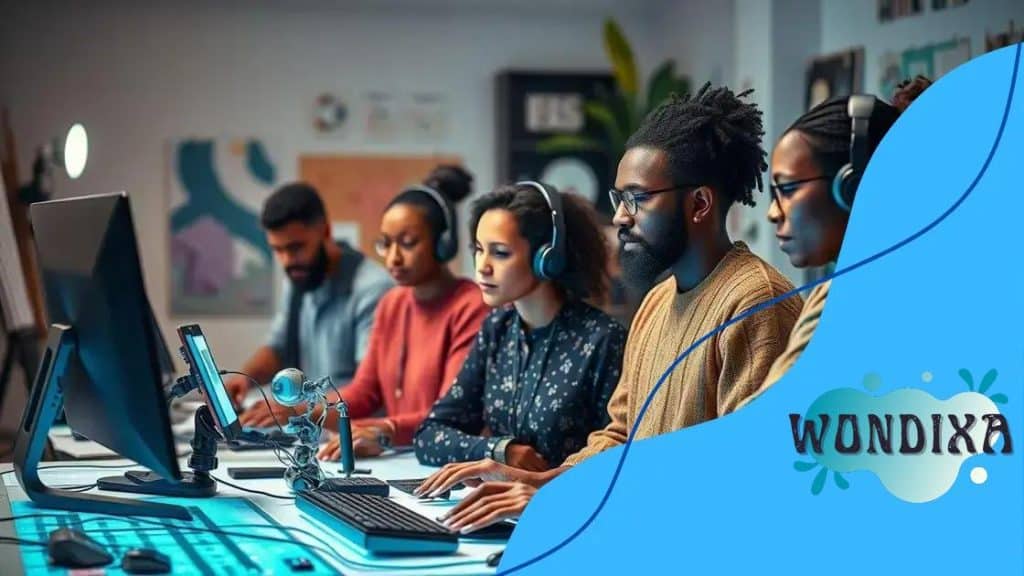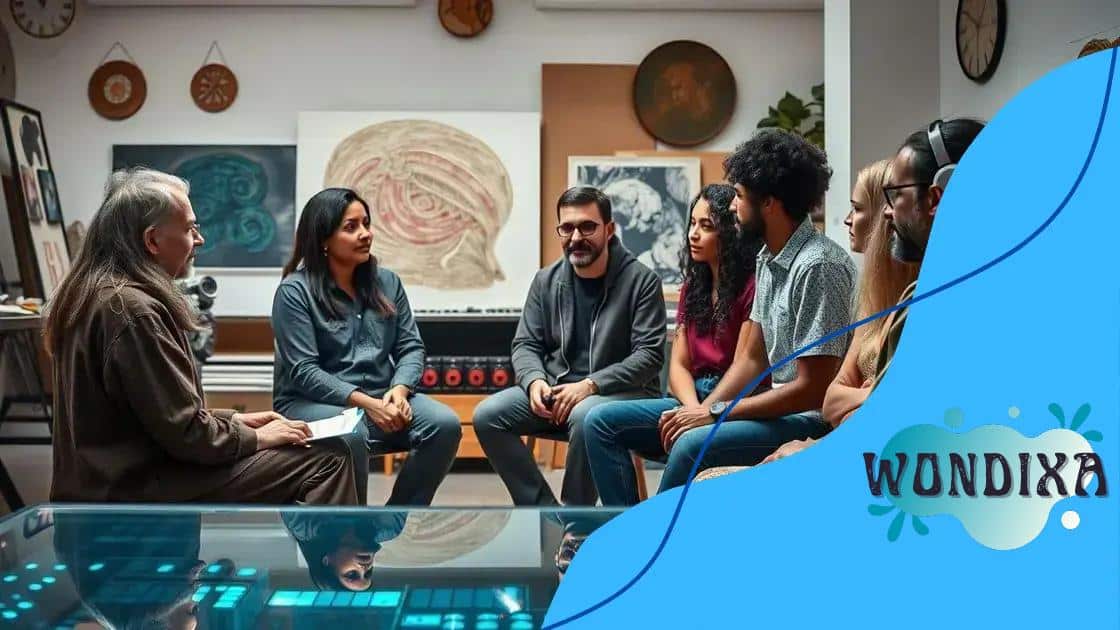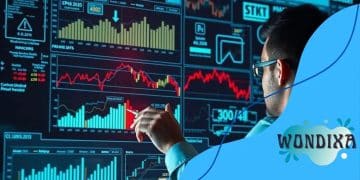The role of AI in transforming the creative industries

The role of AI in transforming the creative industries includes enhancing artistic expression, enabling personalization, and fostering collaboration between human artists and AI technology for innovative outcomes.
The role of AI in transforming the creative industries is emerging as a game-changer, allowing artists to explore new frontiers. Have you ever wondered how these technologies can enhance creativity and drive innovation? Let’s dive in!
Understanding AI’s impact on creativity
Understanding how AI impacts creativity is essential in today’s rapidly evolving landscape. With AI technologies advancing, artists and creators are exploring new methods of expression.
AI Tools in Creative Processes
These tools not only assist in generating new ideas but also enhance artistic workflows. For instance, software can analyze patterns and suggest improvements, making the creative process more efficient.
- Automated design tools help graphic artists create stunning visuals.
- Music composition software generates melodies based on user inputs.
- Photo editing applications utilize AI to enhance images in real-time.
By integrating AI into their practices, creators can push the boundaries of traditional art forms. They collaborate with machines, allowing for unique outcomes that may not be possible through human effort alone.
Examples of AI Enhancing Creativity
Numerous artists now leverage AI to expand their capabilities. For example, some musicians use AI to compose complex pieces that blend various genres. Similarly, visual artists employ algorithms to create mesmerizing patterns.
This fusion of art and technology presents exciting opportunities. Creators can experiment, fail, and iterate in ways that were previously unimaginable. New genres emerge as boundaries blur, and collaboration between humans and machines becomes the norm.
As we further examine the influence of AI, it becomes clear that this technology is driving innovation and redefining what creativity means in the modern world.
How AI tools support artists and content creators
AI tools are becoming essential for artists and content creators, enhancing how they work and express their ideas. With these advancements, creators can access resources that allow them to bring their visions to life more easily.
Types of AI Tools Available
Various AI tools cater to different aspects of the creative process. These tools can simplify tasks and offer new ways to innovate. For instance, digital artists can use software that helps generate concepts, while writers can look to AI for inspiration in their narratives.
- Graphic design AI assists in creating unique visuals quickly.
- AI music composition software offers ideas based on specific genres.
- Content generation tools can help writers brainstorm and structure ideas.
As artists adopt these tools, they can explore creative avenues previously out of reach. The partnership between human creativity and AI technology inspires new art forms. For example, filmmakers can use AI for automated editing, saving time while refining their work.
The Benefits of AI Integration
Incorporating AI into creative workflows has numerous benefits. Not only does it save time, but it also provides artists with more freedom to experiment. With AI handling repetitive tasks, creators can focus on refining their distinctive styles and innovative ideas.
Moreover, AI tools can analyze user engagement, offering creators insights into what resonates with their audience. This feedback loop can help tailor their work, ensuring it meets the needs and preferences of their viewers. Such interaction enhances the creative process, enabling faster evolution and adaptation in their craft.
The ethical side of AI in creative work

The ethical side of AI in creative work raises important questions about ownership, originality, and the impact on human artists. As AI technologies become more integrated into the creative process, understanding these ethical implications is crucial.
Ownership and Copyright Issues
One of the significant concerns surrounding AI-generated content is ownership. Who owns a painting created by an AI? Is it the programmer, the user, or the AI itself? These questions need clear answers as more artists use AI tools.
- Artists may have limited rights over AI-generated works.
- Legal frameworks are still developing in response to these changes.
- Proper attribution and credit for creative AI outputs are needed.
These legal uncertainties can affect how creators approach their work and their willingness to embrace AI in their creative practices.
Impact on Employment
AI’s rise in the creative industries brings concerns about job displacement for artists and content creators. While AI can assist in many tasks, it also raises fears that it could replace human jobs.
However, rather than eliminating jobs, AI may change the nature of creative work. Artists can focus on higher-level creative tasks while AI takes care of repetitive ones. This collaboration can lead to new roles in the creative sector that blend human ingenuity with machine efficiency.
As we look to the future, it is essential to balance technological advancement with ethical considerations to ensure that AI enhances creativity without diminishing the role of human artists.
Case studies of AI in music and art
Case studies of AI in music and art showcase innovative applications that are transforming the creative landscape. Artists and musicians worldwide are harnessing AI technologies to broaden their creative horizons and enhance their work.
AI in Music Creation
Many musicians have started to use AI tools to compose, produce, and even perform music. For example, Amper Music allows users to create and customize original music tracks quickly, using AI algorithms that analyze user preferences and genres.
- OpenAI’s MuseNet can generate complex music compositions blending different styles.
- AIVA (Artificial Intelligence Virtual Artist) composes music for films and games, demonstrating AI’s ability to produce emotional content.
- Jukedeck, now part of TikTok, used AI to create unique background music tracks for videos.
These tools help artists overcome writer’s block, explore new sounds, and streamline the creative process.
AI in Visual Arts
In the world of visual arts, AI algorithms are being used to create stunning artworks. Projects like DeepArt and ArtBreeder allow users to generate images based on AI technology that blends styles and techniques.
For instance, the “Edmond de Belamy” painting produced by the Paris-based collective Obvious was created using a Generative Adversarial Network (GAN) and sold at auction for over $432,000. This event sparked discussions on originality and the role of AI in the art market.
Moreover, Ai-Da, an AI robot artist, can create paintings that reflect human emotions and thoughts, pushing the boundaries of what art can be and blurring the line between human and machine creativity.
Future trends: AI’s role in creative innovation
Future trends indicate that AI will play an increasingly vital role in creative innovation across various industries. As technology evolves, artists and creators will explore new possibilities that AI offers to enhance their creative processes.
Personalization in Creative Works
One exciting trend is the rise of personalization through AI. This technology can analyze data and understand individual preferences, allowing artists to create content tailored to specific audiences. For instance, AI can help musicians generate playlists that resonate with listeners based on their listening habits.
- Customized art pieces can be developed based on a client’s preferences.
- AI-generated music can adapt in real-time to fit different environments.
- Narrative-based games may change storylines dynamically based on player choices.
This shift towards personalization will make the creative experience more engaging for audiences.
Collaborative Creation
Another trend is the concept of collaborative creation between humans and machines. AI tools are not just assistants; they are partners in the creative process. Artists will continue to blend traditional techniques with AI capabilities, leading to innovative art forms.
Additional experiments might emerge, such as AI systems collaborating with human artists to create mixed media installations or interactive experiences that engage the audience in new ways. This cooperation will push the boundaries of creativity and redefine artistic collaboration.
The future will also likely see a rise in AI tools that offer real-time feedback to creators, allowing for quicker iterations and experimentation. By providing constructive suggestions, AI can empower artists to refine their skills and produce high-quality work more efficiently.
FAQ – Questions About AI’s Role in Creative Industries
How is AI changing the way artists create?
AI tools are providing artists with new ways to innovate, enabling them to experiment with styles and techniques that enhance their creativity.
What are the ethical concerns regarding AI in art?
Key concerns include issues of ownership, the potential for job displacement, and ensuring fair attribution for AI-generated works.
Can AI help in personalizing artistic content?
Yes, AI can analyze audience preferences to create personalized art and music experiences tailored to specific demographics.
What future trends should we expect from AI in creative fields?
We can expect increased collaboration between humans and AI, more personalized content, and new art forms that blend traditional techniques with advanced technology.





